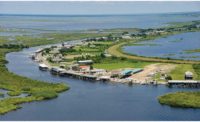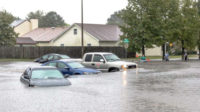Stormwater issues literally come with the territory in Virginia Beach, Va. Almost entirely surrounded by water and permeated with creeks and marshes, Virginia’s most populous city has long coped with flooding across its 310 sq miles, particularly during hurricanes and other major rain events.
Over the past 20 years, those floods have become more frequent and more disruptive, attributable in part, says deputy city manager Tom Leahy, to recent intense development that has outpaced the capacity of the city’s 1950s-era drainage infrastructure.
Leahy adds that nature’s role has increased as well, in the form of accelerating, albeit millimeter-scale, subsidence and rising sea levels. Water levels have risen by nearly 1 ft over the past 50 years, a rate that the Virginia Institute of Marine Sciences projects could increase threefold by the turn of the next century.
“We can tell that flood levels are higher than they used to be,” Leahy says.
Virginia Beach is counting on a pair of data-rich studies, now in the final stages of development, to help prioritize efforts to transition its stormwater infrastructure from playing catch-up to getting ahead of the curve, and better position itself for the climate uncertainties of the future.
A $12-million stormwater master planning study, led by CDM Smith, has modeled the built and natural features of 31 urban watersheds, including 24-in.-dia and larger drainage pipes, as well as subcontainments covering five acres on average. It also delineates tidal patterns for less-developed southern watersheds. CDM technical manager Michael Morgan says the model, built upon public-domain software, “improves the level of detail, and provides good information for updating and assessing new developments as they come along.”
Overlaid with hazard analysis data developed by Dewberry under a separate $4-million contract, the model projects stormwater impacts under a variety of storm scenarios. Leahy says the model is already providing valuable insights, showing, for example, how even a small change in sea level will worsen conditions in existing flood-prone areas and cause new problems in four others.
“We can model down to the parcel level and scope out what needs to be done and what it costs,” Leahy says, adding that while elevating buildings is sometimes an option, “it does no good if the infrastructure is too low.”
Using the model, the city can make its case for infrastructure investments, Leahy adds. “We can also project what will happen if we do nothing.”
Those implications are key for Virginia Beach’s more intensely developed areas, including the tourism-dependent ocean-side resort area, and industrial sites bordering the Elizabeth River to the west. According to Dewberry project manager Brian Batten, “the risk to buildings increases three to four times by the 2050s and ten times by the 2070s.”
Those areas will require what Leahy calls a “New Orleans and Holland approach” of sea walls, berms and pumps, likely costing several billion dollars. Given Virginia Beach’s proximity to several military installations, he says, “we’re hopeful the federal and state governments will provide some assistance.”
Recent increases in local taxes and fees will generate more than $1 billion over the next 15 years to undertake high-priority neighborhood-level drainage infrastructure improvements and boost funds for operations and maintenance.
Heightened awareness of sea-level rise has also become evident in Virginia Beach’s policy decisions. Last year, the City Council cited sea level rise and future flooding as reasons for denying a developer’s rezoning request for a new access road through a low-lying area, even though such projections are not codified. Earlier this year a state court upheld that decision, but it is under appeal.
Neither the tax increase or the rezoning issue was universally popular, but support from Virginia Beach’s leaders is critical to formulating future plans.
“This is not a problem we’re going to solve in five or 10 years,” he says. “This is a 50-year journey that requires taking the long view, and making decisions that our successors will have to live with.”




